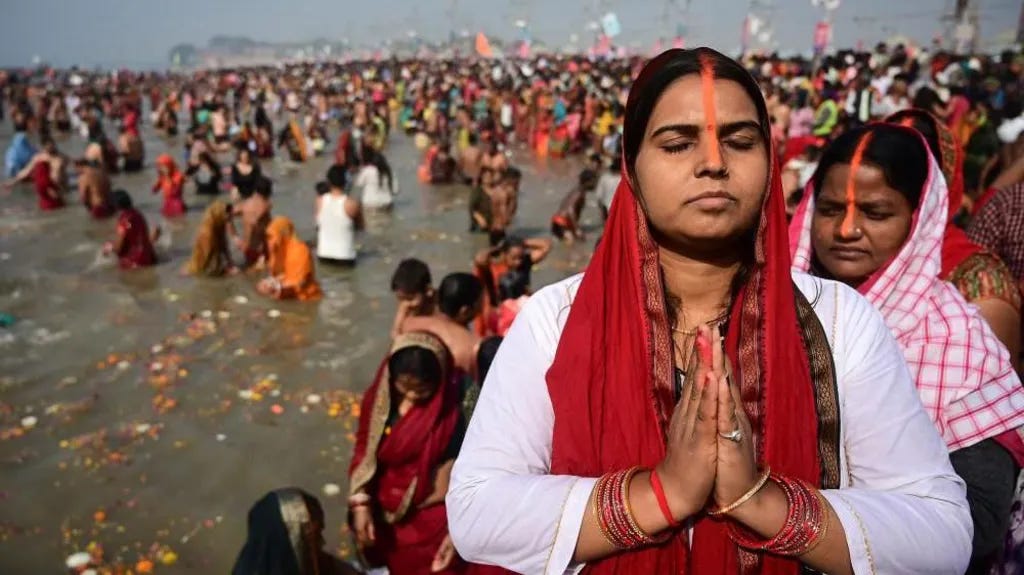Kumbh Mela: Understanding the Significance of the World's Largest Religious Gathering
The Kumbh Mela festival in India has tragically claimed lives in a crowd crush, but its importance as a spiritual event continues to draw millions of people from around the world.
The Kumbh Mela, the largest religious gathering in the world, is a monumental event that attracts millions of Hindu pilgrims to sacred riverbanks in India. The festival, which celebrates Hindu spirituality and rituals, has recently made headlines due to a deadly crowd crush, leaving at least 30 dead and 60 injured. Despite these tragic events, the significance of Kumbh Mela remains unshaken for many devotees.
What is Kumbh Mela?
Kumbh Mela is a massive religious gathering that brings together tens of millions of pilgrims from India and across the globe. The festival revolves around the Hindu belief in the purifying power of sacred rivers, where participants bathe in the waters to cleanse themselves of sins and move closer to spiritual liberation.
The festival is held in four key cities in India: Prayagraj (formerly Allahabad), Haridwar, Nashik, and Ujjain. Each of these locations is linked to a sacred river – the Ganges, Godavari, or Shipra. A full Kumbh Mela is held every 12 years in these cities, while a half or "Ard" Kumbh occurs between two full festivals.
2025’s event is a Maha (Great) Kumbh Mela, which occurs only once every 144 years, making it an especially significant occasion for participants.
The Meaning Behind Kumbh Mela
The name "Kumbh Mela" translates to the "Festival of the Pitcher" in Sanskrit. The "Kumbh" refers to a mythical pitcher that contained the nectar of immortality, while "Mela" means a fair or gathering. Hindu mythology recounts the tale of the Samudra Manthan, the churning of the ocean of milk by gods and demons in search of immortality’s nectar. Four drops of this nectar are believed to have fallen at the locations where Kumbh Mela is celebrated, adding to their sacredness.
Why Do People Attend Kumbh Mela?
Kumbh Mela attracts people from all walks of life, from Hindu holy men (sadhus) to everyday citizens, families, and international visitors. While predominantly a Hindu event, it draws people of all faiths curious about its cultural and spiritual significance.
For many attendees, the festival offers a chance for spiritual renewal and salvation. Bathing in the sacred rivers is believed to absolve sins, break the cycle of rebirth, and bring participants closer to achieving moksha (spiritual liberation).
Duration of Kumbh Mela
Typically lasting around 45 days, Kumbh Mela is a major event in the Hindu calendar. The 2025 festival, which takes place from January 13 to February 26, will conclude after the final royal bathing day, called the "shahi snan."
The timing of Kumbh Mela is determined by astrologers and religious authorities, who base it on the alignment of celestial bodies.
What Happens During Kumbh Mela?
The festival is a blend of religious rituals, spiritual discussions, cultural performances, and religious processions. Its highlight is the "shahi snan" (royal baths), where holy men, including the naga sadhus who symbolically renounce the material world, take ceremonial dips in the sacred rivers.
Temporary camps are set up by religious organizations to provide food, shelter, and spiritual learning opportunities for attendees.
How Many People Attend Kumbh Mela?
The scale of Kumbh Mela is unprecedented. For the 2025 Maha Kumbh Mela in Prayagraj, authorities estimate that around 400 million people will attend during the 45-day period. The massive crowds are spread across the banks of the rivers, covering about 12 km.
To manage such a large gathering, officials use a combination of CCTV, drones, and mobile phone data to monitor crowd density and ensure safety. Daily headcounts and surveillance help keep track of attendance.
Managing the Kumbh Mela Event
Organizing Kumbh Mela is an enormous logistical challenge. Authorities set up temporary cities with infrastructure to accommodate the millions of visitors. This includes makeshift hospitals, sanitation systems, transportation networks, and security measures. For the 2025 festival, the setup will span 4,000 hectares (40 sq km), including 160,000 tents, 40,000 police officers, 15,000 sanitation workers, and 150,000 toilets.
Despite the risks associated with such a massive gathering, Kumbh Mela remains a deeply significant spiritual and cultural event for millions, providing a chance to renew faith, purify the soul, and connect with the Hindu tradition.


